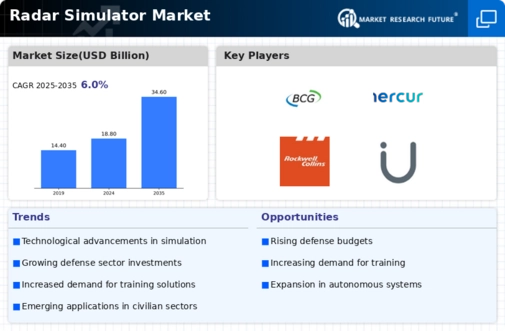Top Industry Leaders in the Radar Simulator Market

Key Players
AAI Corporation (US)
ARI Simulation (India)
Acewavetech (South Korea)
Buffalo Computer Graphics (US)
Cambridge Pixel Ltd (US)
Adacel Technologies Limited (Australia)
Harris Corporation (US)
Mercury Systems (US)
Micro Nav Limited (UK)
Rockwell Collins (US)
Presagis Canada Inc. (Canada)
Ultra Electronics Inc. (UK).
Strategies Adopted The competitive landscape is characterized by strategic initiatives aimed at enhancing technological capabilities, expanding market reach, and staying ahead of the curve. Key players often adopt collaborative strategies, forming partnerships with defense organizations, research institutions, and technology providers to pool resources and expertise. For instance, strategic alliances between radar simulator manufacturers and military agencies facilitate the development of customized solutions aligned with specific defense requirements.
Furthermore, a focus on research and development is evident in the deployment of cutting-edge technologies such as synthetic aperture radar (SAR) simulation, multi-sensor integration, and advanced modeling techniques. Companies like Adacel Technologies invest significantly in R&D to ensure that their simulators replicate real-world scenarios with utmost precision. This commitment to innovation is a key differentiator in the competitive landscape.
Factors for Market Share Analysis Several factors contribute to the analysis of market share within the radar simulator market. Technical expertise and the ability to provide realistic simulation experiences are paramount, as defense and aerospace clients seek simulators that closely mimic actual operational conditions. The versatility of simulation solutions, spanning radar systems used in air traffic control, naval operations, and missile defense, is another crucial factor influencing market share.
Established relationships with defense agencies and governments worldwide are significant determinants of market share. Companies with a strong global presence and a history of successful collaborations are better positioned to secure contracts for large-scale simulation projects. Additionally, ongoing customer support, training programs, and the adaptability of simulators to evolving radar technologies contribute to customer satisfaction, influencing market share dynamics.
New and Emerging Companies While established players dominate the radar simulator market, a wave of new and emerging companies is making its presence felt. These companies often bring fresh perspectives and innovative solutions to the table. One such example is Presagis, a company gaining recognition for its radar simulation technologies that focus on enhancing situational awareness in complex environments. The emergence of these companies reflects the market's openness to novel approaches and technologies, challenging traditional players to adapt and innovate.
Start-ups specializing in artificial intelligence (AI) and machine learning (ML) applications in radar simulation are also on the rise. These companies aim to revolutionize simulation accuracy by leveraging AI algorithms that continuously learn and adapt to dynamic scenarios. As these new entrants gain traction, they contribute to the overall diversity and competitiveness of the radar simulator market.
Industry News Keeping abreast of industry news is essential for understanding the radar simulator market's competitive dynamics. Recent developments indicate a growing demand for radar simulators that can emulate complex electronic warfare scenarios, including jamming and anti-jamming techniques. This aligns with the evolving threat landscape, where military forces seek advanced training solutions to counter sophisticated electronic warfare tactics.
The integration of cloud-based solutions in radar simulation is another notable trend, offering scalability, accessibility, and collaborative capabilities. This shift toward cloud-based platforms enables remote training and simulation exercises, addressing the global nature of defense collaborations and the need for cost-effective, flexible training solutions.
Current Company Investment Trends Investment trends within the radar simulator market underscore the industry's commitment to staying at the forefront of technological advancements. Companies are allocating resources to research and development, with a particular focus on artificial intelligence, machine learning, and augmented reality. These investments aim to enhance the fidelity of simulations, providing users with more immersive and realistic training experiences.
Moreover, companies are investing in cybersecurity measures to address the increasing threats to simulation systems. As radar simulators become more interconnected and data-driven, protecting sensitive information and ensuring the integrity of simulated scenarios have become critical priorities. Investment in cybersecurity technologies and partnerships with cybersecurity experts are indicative of the industry's proactive approach to safeguarding simulation systems.
Overall Competitive Scenario
the radar simulator market is characterized by a competitive landscape shaped by key players with global reach, new entrants bringing innovative solutions, and ongoing technological advancements. Strategic initiatives, collaborative partnerships, and a commitment to research and development are common threads among established companies aiming to maintain their competitive edge.
Market share analysis revolves around factors such as technical expertise, versatility of simulation solutions, and established relationships with defense agencies. The emergence of new companies, especially those exploring AI and ML applications, adds a layer of dynamism and innovation to the market. Industry news highlights the market's responsiveness to evolving threats and the adoption of cloud-based solutions, while current investment trends emphasize the importance of staying technologically relevant and resilient in an ever-changing landscape.
As the radar simulator market continues to evolve, companies that can navigate these trends, adapt to emerging technologies, and forge strategic collaborations are likely to emerge as leaders in this critical sector that underpins the training and readiness of defense and aerospace forces worldwide.
Recent News
Adacel Technologies Limited (Australia)
Secured a major contract with the Royal Australian Navy to provide their advanced radar simulator systems for training on various naval radar platforms.
Unveiled a new software upgrade with enhanced simulation scenarios and improved environmental modeling, making their simulators even more realistic.
Mercury Systems Inc. (USA)
Launched a new line of high-fidelity radar simulators utilizing commercial off-the-shelf (COTS) components for improved affordability and maintainability.
Won a contract from the U.S. Air Force to upgrade their existing radar simulators with advanced signal processing and jamming simulation capabilities.


